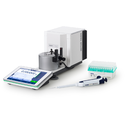Pipette performance verifications according to ISO 8655 are essential to ensure your liquid handling precision instrument is working accurately.
To maintain consistent accuracy of pipetted volumes, pipettes should be calibrated and tested regularly. Pipette calibration is usually performed by a specialized service provider, who will provide a calibration certificate that includes an assessment of the pipette’s measurement uncertainty. In the intervals between calibrations, routine pipette testing carried out by the user ensures a pipette continues to perform according to its specifications. A simple routine test quickly confirms that the instrument is still fit for its intended use and drastically reduces risks of out-of-tolerance (OOT) results.
How does weighing relate to pipette performance?
One of the most important methods for checking pipette performance is using a balance to weigh the liquid delivered by the pipette. The volume of the liquid is then calculated and compared to the expected value. The International Organization of Standardization (ISO) details the requirements for the gravimetric reference measurement procedure for the determination of volume. ISO 8655-6 includes minimum requirements for balances according to the nominal volume of the pipette under test. ISO updated the standard for piston-operated volumetric apparatuses (POVA) in 2022.






















